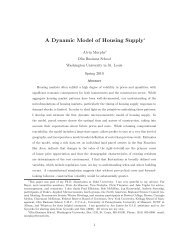Shopping Externalities and Self Fulfilling Unemployment Fluctuations*
Shopping Externalities and Self Fulfilling Unemployment Fluctuations*
Shopping Externalities and Self Fulfilling Unemployment Fluctuations*
You also want an ePaper? Increase the reach of your titles
YUMPU automatically turns print PDFs into web optimized ePapers that Google loves.
claims). However, they certainly indicate that sentiment shocks are a promising explanationfor the recent behavior of the US economy.The …rst contribution of the paper is to identify <strong>and</strong> quantify a novel set of externalities—the shopping externalities— that can lead to strategic complementarities in the employmentdecision of di¤erent …rms <strong>and</strong>, in turn, to multiple rational expectations equilibria. The…rst shopping externality is a st<strong>and</strong>ard dem<strong>and</strong> externality, i.e. when a …rm increases itsworkforce, it increases the dem<strong>and</strong> facing other …rms’because employed workers spend morethan unemployed workers. The second shopping externality is a market power externality,i.e. when a …rm increases its workforce, it lowers the extent of competition among other …rmsbecause employed workers spend less time searching for low prices than unemployed workers.Theoretically, the presence of dem<strong>and</strong> externalities has long been recognized as a possiblesource of multiplicity (see, e.g., Heller 1986, Roberts 1987, Blanchard <strong>and</strong> Kiyotaki 1988,Cooper <strong>and</strong> John 1988, <strong>and</strong> Gali 1996). Quantitatively, though, we …nd that the dem<strong>and</strong>externality alone is not su¢ cient to generate multiplicity because of the small empiricaldi¤erences between the expenditures of employed <strong>and</strong> unemployed workers. In contrast, we…nd that the combination of the dem<strong>and</strong> externality <strong>and</strong> the market power externality isstrong enough to generate multiple equilibria.Several papers generate strategic complementarities in the employment decision of different…rms <strong>and</strong>, in turn, generate multiple rational expectations equilibria by assumingincreasing returns to scale in either matching or production. For example, Diamond (1982),Diamond <strong>and</strong> Fudenberg (1989) <strong>and</strong> Boldrin, Kiyotaki <strong>and</strong> Wright (1993) generate multiplicityby assuming increasing returns to scale in the product market matching function.Similarly, Benhabib <strong>and</strong> Farmer (1994), Farmer <strong>and</strong> Guo (1994), Christiano <strong>and</strong> Harrison(1999) <strong>and</strong> Mortensen (1999) generate multiplicity by assuming increasing returns to scalein the production function. In contrast, in our model, both the production <strong>and</strong> the matchingtechnologies have constant returns to scale. Moreover, while there is no compelling empiricalevidence of increasing returns to scale in either production or matching, we …nd thatthe empirical di¤erences in the shopping behavior of employed <strong>and</strong> unemployed workers arestrong enough to generate multiple equilibria.The type of multiplicity obtained in our model— i.e. multiple rational expectations equilibrialeading to di¤erent steady states— is di¤erent from the one obtained in Benhabib <strong>and</strong>Farmer (1994) <strong>and</strong> Farmer <strong>and</strong> Guo (1994)— i.e. multiple rational expectations equilibrialeading to the same steady-state equilibrium. Similarly, the type of non-fundamental shocksthat are introduced in our model are shocks to the agents’expectations about future longrunoutcomes, while non-fundamental shocks in Benhabib <strong>and</strong> Farmer (1994) <strong>and</strong> Farmer5
















